"A man, who knows everything of shinobi no jutsu and takes ownership of what he has learned, while at the same time always keeping it in mind and conducting himself independently, is called shinobi" - Natori Masatake (Shoninki)
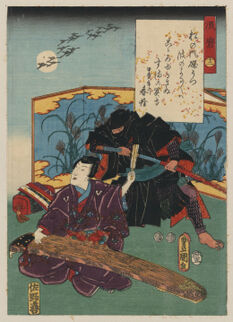
Shinobi no mono, mitsumono, or ninja (忍者), were military units or single agents utilized by the medieval samurai clans and families of Japan. These were specialists in clandestine and guerrilla warfare, espionage, infiltration, arson, explosives and thievery – areas that all come under the term shinobi no jutsu, or the arts of the shinobi. The shinobi themselves were taken from any social class but tended to come from the lower samurai ranks and worked as retainers for a clan lord. This relationship was either a continued and loyal service or was temporary and mercenary in nature. While still a part of the samurai culture, the shinobi were specialized and few in number when seen in army listings; approximately one for every four hundred men in an army, and should be considered as men who partook in what are known as ‘black ops’ and undercover agents who infiltrated the enemy lines and acted in espionage.
Sometimes a shinobi would work with one or more shinobi, as stated in the Shoninki manual. For example, a shinobi could be used to distract guards while another creeps into a mansion. The larger a shinobi team is, the more difficult it is to complete the mission although there are advantages to doing so. Shinobi could help each other climb walls or have one stand on watch during infiltration. If one is caught they could pretend that the shinobi is a thief and they are just passerbys attempting to catch him. Distractions could also be done more effectively if more people are involved. Passwords or aijirushi (相印) identification marks should be utilized.
The Giyoshu military manual advocates the use of five different colored sections of paper, rice, or beans, when multiple shinobi no mono venture out as a group. They should make arrangements for the "signs for the name", "signs to attract attentions" and "signs for the route". The colored fragments or rice would be used when a road splits, at a river, or in any place in which they need guidance.
The same manual claims shinobi could even be used to guard gates and back alleys when a group of twenty or thirty people stand watch over prisoners day and night by taking shifts. Although, this could have been a job for them only during the Edo period.
In Japanese Kanji (漢字), the characters of shinobi are written as "忍者" . "忍" means "endure" and "者" is "man". In short, shinobi means someone who can endure hardships. Moreover, the kanji "忍" can be separated into these two kanjis. They are "刃" and "心". The meaning of 刃 is "edge", similarly 心 is "heart". There is an edge on one's heart. It indicates the abandonment of one's individual emotions.
There have been many names given to ninjas. "Shinobi (忍 )"," Ninsya (ニンシャ) ", " Onmitsu (隠密) ", " Ninjutsusya (忍術屋) ", " Monomi (物見) " to name but a few. After the Pacific War, some famous novelists called them ninja in their written works. Since then, the classic name for a Japanese spy has been ninja.
History

The first Chinese Emperor Shi-Huangdi (始皇帝)
"It has been many years since the basis for the arts of the shinobi soldiers was brought to these shores from abroad. The arts of the shinobi soldier are a rudder in the planning of a strategy and the key to success for all tacticians." - Katsuda Kakyusai Yoshin (Shoninki)
Birth of the Shinobi
In 221 BC, the first Chinese Emperor Shi-Huangdi (始皇帝) unified all of China. According to a certain historical legend, he dispatched a man named Xu Fu (徐福) to Japan in order to obtain the elixir of immortality. Xu Fu brought back his wizardry, and it became the base of shinobi no jutsu (忍術).
Pre-Warring States Period
In the 7th century and throughout the times that followed, a certain document says that a great politician called Shotoku-Taishi (聖徳太子) used a man named Otomono Hosohito (大伴 細人) as a spy. Otomono Hosohito is thought to be the ancestor of shinobi.
In the classical ages of Japan, there existed two types of tribes. One were the aborigines of Japan called Jomon-jin (縄文人) and the other were the groups who passed on rice farming from Eurasia, called Yayoi-jin (弥生人). Around the 8th century, Yayoi-jins took the leadership of the Japanese governance. At that time, the Jomon-jin were banished into the mountains with their beliefs and techniques.
Until the Warring States period in Japan, almost all territories had been private lands called Shoen (荘園) ruled by priests, aristocracy and bureaucrats. Great battles among the large groups of Samurai (侍) often took place thus, around the 14th century, shinobi were hired by samurais as spies.
Shinobi Golden Age
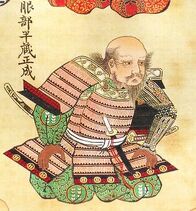
Hattori Hanzo
During the Waring States Period, each Daimyo possessed areas in Japan and they waged wars with each other for the unification of the whole country. This period continued throughout the 15th and 16th century and this was the golden-age of the shinobi. Some shinobi took part in the battles as guerrilla mercenaries which specialized in surprise raids. Daimyos spent all their time on war so they permanently desired information on their enemies therefore, many shinobi behaved as spies.
At that time, two historical shinobi appeared. Hattori Hanzo (服部 半蔵) and Fuma Kotaro (風魔 小太郎). They attained great results for their lords. Especially Hanzo, as he served Tokugawa, Ieyasu (徳川 家康), and was given a large home in a heart of Edo, present-day Tokyo, by Ieyasu as a reward. The name of his residence still remains today, it’s called Hanzomon (半蔵門).
The Iga (伊賀) and Koka (甲賀) regions famous for their skilled shinobi became enemies of a great Daimyo and a Shogun (将軍). The result of this was a fierce battle that sent shinobi fading away from Japanese history.
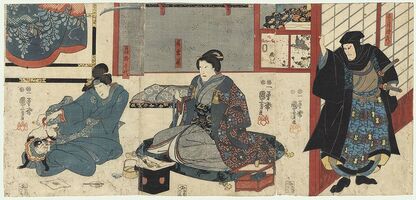
Edo Period
Tokugawa Ieyasu unified all of Japan and started the Edo-Shogunate (江戸幕府) in 1603. The Warring States period ended and the peaceful Edo-age had begun. This led to the decline of the shinobi as a force on the battlefield and prompted them to concentrate more on the espionage aspect of their skill set. This decline prompted an increase in the compiling of shinobi records, with the aim of preserving the ways of the shinobi.
More and more families who were trained in the arts of shinobi no jutsu began to fail in their military education and the shinobi, while not extinct, in many respects became less functional as agents. This shift into an age where the shinobi were no longer required, and their subsequent fall, was well documented during the Edo Period (1603–1868) and must be viewed alongside the decline of Iga and Koka, which were independent and self-sustaining regions, where the social elite were considered independent families, who were then without land income and who now came under the heavy hand of taxation and servitude. These issues, alongside a lack of demand for their military services, pushed shinobi families financially and even into poverty. As a result of this there were various attempts by the families of Koka to gain government employment and sponsorship to help continue their military training.
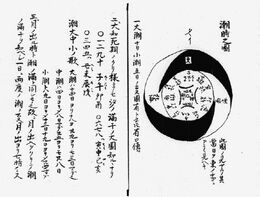
Diagram from the Bansenshukai that uses divination and esoteric cosmology (onmyōdō) to instruct on the ideal time for taking certain actions.
In 1667 Akutagawa Gingobei attempted to gain employment for the families of Koka warriors, which is recorded in a document similar to, or connected to, the Koka Ninshi Yuishogaki of 1815 – a transcription of a 1789 document discussing the background and activities of the warriors of Koka. It lists the Koka samurai, what they did and their ancestry and in this record, they insisted that the Koka warriors first served Tokugawa Ieyasu in 1560, and at the battles of Mikawa, Udono and Taiji. It also includes their service at Komaki Nagakute which was in 1584 and the defence of Fushimi castle just before the battle of Sekigahara (1600). And also the hiring of a band of one hundred Koka warriors by the shogun, and finally the service of Koka warriors at the Shimabara Christian rebellion, where ten warriors of Koka fought under Matsudaira Izu-no-Kami Nobutsuna. The next major attempt at employment by the warriors of Koka was made in 1789 when Ohara Kazuma, Ueno Hachizaemon and Oki Moriichiro visited the capital of Edo with a copy of the Bansenshukai and presented it, along with a sake cup, to the magistrate, Matsudaira Ukyonosuke. Their aim was to display their heritage and professionalism and the dire status of the families in Koka, some of which they claim no longer taught their ancient family arts of the shinobi. After accepting the Bansenshukai, the magistrate offered them a small donation of silver coins and another token amount of silver to give to the other families in Koka. The copy of the Bansenshukai that they presented is still kept in National Archives of Japan.
The importance of shinobi in Japan diminished. Some shinobi who worked under Ieyasu got important posts as guards around Edo-castle (江戸城). As Ieyasu needed to look out for all of the Daimyos in Japan, other shinobi were dispatched to each Daimyo’s territor. They all had to survive by using their special talents and skills. Some became gunpowder experts, some got jobs as pharmacists, gardeners, street performers, policemen or lower level Samurai (下級武士) while others became priests. The most talented shinobi became Kogi-Onmitsu.
Ten Ideals of a Shinobi According to the Bansenshukai (萬川集海) Manual
- To maintain a strong body, with loyalty, bravery, stratagem, skills, and belief.
- To be gentle and faithful with less desire, to value academies, to remember obligations.
- To be eloquent, to read domestic and foreign books, to be wise enough not to be cheated by anyone.
- To know providence, to master the teachings of Buddhism and Confucianism, and to realize one's destiny.
- To respect ancient, domestic and foreign ethos, to wear a heroic temper.
- To be called a good man usually without arguing with anyone.
- To have a tidy family and relatives, never to betray anyone and abuse shinobi no jutsu.
- To travel around all countries, and to know the customs and manners of each land well.
- To have a talent for literature, to excel in writing and to possess a talent for and keen understanding of military affairs.
- To acquire artistic accomplishments like singing and dancing, traditional Japanese music, making impressions of others, and to utilize them when necessary.
Sun Tzu's Five Types of Spy
"When these five sorts of espionage are in operation, no one knows the way of it. It is called the Mysterious Skein, the Lord's Treasure" - Sun Tzu (Art of War)
Inko no kan: Local Spies
These spies act as informants. They are information gatherers, spies, masters of deception, and are usually from enemy territory. They would be fluent in the local dialects.
Nairyo no kan: Inward Spies
These spies would be planted in the enemies' inner circle. They would be trained and conditions years beforehand as to not betray their original masters. Sometimes they would simply be enemy officials who have been convinced to work for the other side.
Hantoku no kan: Double Agents
These spies would be enemy spies that have been forced or convinced to work for our side or simply fed false information. This technique is called kaerinin or sorinin. According to the Shoninki ninja manual, if a person from the lower class speaks with more reason or intelligence that befits their status, they should be suspected of being enemy spies. They would be either killed or won over with bribes.
According to Sun Tzu's Art of War, double agents can be used to discover the enemy's local and internal spies and convey misinformation to the enemy. Double agents must be treated generously.
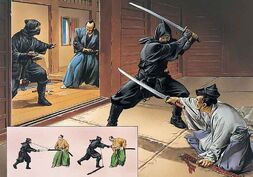
Shicho no kan: Doomed Spies
These spies are sent out on suicide missions, with or without their knowledge.
Tensei no kan: Persisting Spies
These spies are highly skilled in espionage and spying by infiltrating enemy lines.
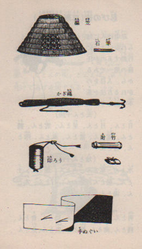
Shoninki's Essential Equipment
- Large straw hat called amigasa
- Grappling hook called kaginawa
- Stone pencil called sekihtsu
- Field medicine called kusuri
- Piece of cloth around ninety centimeters (3 feet) called sanjaku tenugui
- Fire starting piece of equipment called uchitake or tsuketake